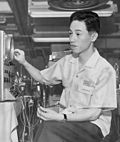Leo Esaki
Reona Esaki (江崎 玲於奈 Esaki Reona, born March 12, 1925), also known as Leo Esaki, is a Japanese physicist. He was awarded the Nobel Prize in Physics in 1973 with Ivar Giaever and Brian David Josephson. He won the prize for his discovery of the phenomenon of electron tunneling. [1]
Leo Esaki | |
|---|---|
 Leo Esaki in 1959 | |
| Born | 12 March 1925
(aged 100) |
| Nationality | Japan |
| Alma mater | University of Tokyo |
| Known for | electron tunneling, Esaki diode |
| Awards | Stuart Ballantine Medal (1961) Nobel Prize in Physics (1973) IEEE Medal of Honor |
| Scientific career | |
| Fields | Applied physics |
He is known for his invention of the Esaki diode, which exploited that phenomenon. This research was done when he was with Tokyo Tsushin Kogyo (now known as Sony). He has also contributed in being a pioneer of the semiconductor superlattice while he was with IBM.
Esaki was born on March 12, 1925 in Higashiōsaka, Japan.[2] He studied at the University of Tokyo.
Leo Esaki Media
1N3716 Esaki diode (with 0.1" jumper for scale)
References
- ↑ Esaki, L.; Tsu, R. (1970). "Superlattice and Negative Differential Conductivity in Semiconductors". IBM Journal of Research and Development. 14: 61–65. doi:10.1147/rd.141.0061.
- ↑ Esaki, Leo, "Long Journey into Tunneling," Nobel Lecture, Dec 12, 1973.
Other websites
- Leo Esaki – Biography. Retrieved Aug. 5, 2003 from http://www.nobel.se/physics/laureates/1973/esaki-bio.html Archived 2004-08-03 at the Wayback Machine
- IBM record
- IEEE History Center – Leo Esaki. Retrieved Jul. 19, 2011 from http://www.ieeeghn.org/wiki/index.php/Leo_Esaki
- Sony History – The Esaki Diode. Retrieved Aug. 5, 2003 from http://www.sony.net/Fun/SH/1-7/h5.html Archived 2003-08-04 at the Wayback Machine
- Freeview video 'An Interview with Leo Esaki' by the Vega Science Trust

